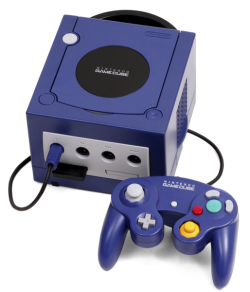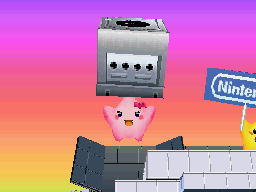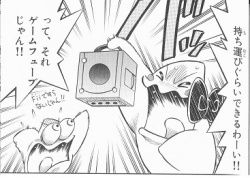Nintendo GameCube: Difference between revisions
Torchickens (talk | contribs) No edit summary |
Torchickens (talk | contribs) No edit summary |
||
| (3 intermediate revisions by the same user not shown) | |||
| Line 1: | Line 1: | ||
[[File:GameCube.png|thumb|right|250px|A purple Nintendo GameCube]] | [[File:GameCube.png|thumb|right|250px|A purple Nintendo GameCube]] | ||
The '''[[nwiki:Nintendo GameCube|Nintendo GameCube]]''' (Japanese: ニンテンドーゲームキューブ), shortened as the '''GameCube''' and officially abbreviated as the '''GCN''' ('''NGC''' in Japan) is [[Nintendo]]'s [[wikipedia:sixth generation of video game consoles|sixth generation home console]], released in 2001 in Japan and North America and 2002 in Europe and Australia. It is the successor to the [[nwiki:Nintendo 64|Nintendo 64]] and the predecessor to the [[Wii]]. | The '''[[nwiki:Nintendo GameCube|Nintendo GameCube]]''' (Japanese: ニンテンドーゲームキューブ), shortened as the '''GameCube''' and officially abbreviated as the '''GCN''' ('''NGC''' in Japan) is [[Nintendo]]'s [[wikipedia:sixth generation of video game consoles|sixth generation home console]], released in 2001 in Japan and North America and 2002 in Europe and Australia. It is the successor to the [[nwiki:Nintendo 64|Nintendo 64]] and the predecessor to the [[Wii]]. | ||
''[[Donkey Konga]]'' was released on this console; which features [[Becky]]'s version of [[The Legendary Starfy (series)|''The Legendary Starfy'' series]] [[Title Song (music)|Title Song]] in the Japanese version. | |||
A special version of the Nintendo GameCube was released by [[wikipedia:Panasonic|Panasonic]] called the [[nwiki:Panasonic Q|Panasonic Q]], which has the ability to play DVDs and audio CDs as well as GameCube games. This version of the GameCube was only released in Japan but was discontinued in December 2003. | A special version of the Nintendo GameCube was released by [[wikipedia:Panasonic|Panasonic]] called the [[nwiki:Panasonic Q|Panasonic Q]], which has the ability to play DVDs and audio CDs as well as GameCube games. This version of the GameCube was only released in Japan but was discontinued in December 2003. | ||
Though no games in | Though no games in ''The Legendary Starfy'' series were released for the GameCube, it is possible to play the [[Game Boy Advance]] games via an add-on called the [[wikipedia:Game Boy Player|Game Boy Player]] (Japanese: ゲームボーイプレーヤー). | ||
==In ''[[Densetsu no Starfy 3]]''== | ==In ''[[Densetsu no Starfy 3]]''== | ||
| Line 12: | Line 14: | ||
[[File:Gamecube DnS3.PNG|thumb|left|150px|The GameCube cameo]] | [[File:Gamecube DnS3.PNG|thumb|left|150px|The GameCube cameo]] | ||
{{clrl}} | {{clrl}} | ||
==In ''[[Densetsu no Starfy 4]]''== | |||
[[File:GameCube DnS4.png|frame|right|Starly holding the silver GameCube in the Nintendo Headquarters Special]] | |||
A silver Nintendo GameCube appears in ''[[Densetsu no Starfy 4]]'''s [[List of cameos#Nintendo Headquarters Special|Nintendo Headquarters]] [[Stuff|Special]] in the [[Stuff]], where Starly (if Starfy 'wears' it) or Starfy (if Starly 'wears' it) jumps out of the top of the building holding the GameCube and falls back into the building again. | |||
{{clrr}} | |||
==In the ''[[Densetsu no Starfy R]]'' manga== | ==In the ''[[Densetsu no Starfy R]]'' manga== | ||
[[File:GameCube DSR.jpg|thumb|right|250px|Starly lifting up the Gamefyūbe in "[[DSR07|Pufftop Kingdom, Game King Playoff]]"]] | [[File:GameCube DSR.jpg|thumb|right|250px|Starly lifting up the Gamefyūbe in "[[DSR07|Pufftop Kingdom, Game King Playoff]]"]] | ||
A console resembling the Nintendo GameCube appeared in chapter seven of the ''[[Densetsu no Starfy R]]'' manga — "[[DSR07|Pufftop Kingdom, Game King Playoff]]", where it was known as the '''Gamefyūbe''' (Japanese: ゲームフューブ). After [[Starfy]] said that the "[[Nintendo DS|FS]]" is useful because it can be carried around and played anywhere, [[Starly]] picked up the Gamefyūbe and said that the Gamefyūbe is able to be carried around too. | A console resembling the Nintendo GameCube appeared in chapter seven of the ''[[Densetsu no Starfy R]]'' manga — "[[DSR07|Pufftop Kingdom, Game King Playoff]]", where it was known as the '''Gamefyūbe''' (Japanese: ゲームフューブ). After [[Starfy]] said that the "[[Nintendo DS|FS]]" is useful because it can be carried around and played anywhere, [[Starly]] picked up the Gamefyūbe and said that the Gamefyūbe is able to be carried around too. | ||
{{clr}} | |||
==Game Boy Player== | |||
The Game Boy Player is a peripheral with a Game Boy cartridge slot that attaches to the bottom of the Nintendo GameCube. This peripheral is to be used with a special disc which allows for the player to play Game Boy, Game Boy Color and Game Boy Advance games on a television (much like the previously released Super Game Boy and Super Game Boy 2, although these couldn't play Game Boy Advance games and had special borders unique per game). The Game Boy Player can be used to play ''[[Densetsu no Starfy]]'', ''[[Densetsu no Starfy 2]]'' and ''[[Densetsu no Starfy 3]]''. | |||
==References== | ==References== | ||
Latest revision as of 20:13, 26 September 2018

The Nintendo GameCube (Japanese: ニンテンドーゲームキューブ), shortened as the GameCube and officially abbreviated as the GCN (NGC in Japan) is Nintendo's sixth generation home console, released in 2001 in Japan and North America and 2002 in Europe and Australia. It is the successor to the Nintendo 64 and the predecessor to the Wii.
Donkey Konga was released on this console; which features Becky's version of The Legendary Starfy series Title Song in the Japanese version.
A special version of the Nintendo GameCube was released by Panasonic called the Panasonic Q, which has the ability to play DVDs and audio CDs as well as GameCube games. This version of the GameCube was only released in Japan but was discontinued in December 2003.
Though no games in The Legendary Starfy series were released for the GameCube, it is possible to play the Game Boy Advance games via an add-on called the Game Boy Player (Japanese: ゲームボーイプレーヤー).
In Densetsu no Starfy 3
In Densetsu no Starfy 3, by using multiple Game Boy Advance Game Link Cables, minigames can be played with up to four players on the Nintendo GameCube. [1][2]
Additionally, a purple Nintendo GameCube with two controllers appears on the minigames menu, where it is connected to a television. Only two GameCube controllers and a television can be seen, unless the player switches between the minigames.

In Densetsu no Starfy 4

A silver Nintendo GameCube appears in Densetsu no Starfy 4's Nintendo Headquarters Special in the Stuff, where Starly (if Starfy 'wears' it) or Starfy (if Starly 'wears' it) jumps out of the top of the building holding the GameCube and falls back into the building again.
In the Densetsu no Starfy R manga

A console resembling the Nintendo GameCube appeared in chapter seven of the Densetsu no Starfy R manga — "Pufftop Kingdom, Game King Playoff", where it was known as the Gamefyūbe (Japanese: ゲームフューブ). After Starfy said that the "FS" is useful because it can be carried around and played anywhere, Starly picked up the Gamefyūbe and said that the Gamefyūbe is able to be carried around too.
Game Boy Player
The Game Boy Player is a peripheral with a Game Boy cartridge slot that attaches to the bottom of the Nintendo GameCube. This peripheral is to be used with a special disc which allows for the player to play Game Boy, Game Boy Color and Game Boy Advance games on a television (much like the previously released Super Game Boy and Super Game Boy 2, although these couldn't play Game Boy Advance games and had special borders unique per game). The Game Boy Player can be used to play Densetsu no Starfy, Densetsu no Starfy 2 and Densetsu no Starfy 3.
References
- ↑ Nintendo - Customer Service Nintendo GameCube - Game Boy Player Multiplayer
- ↑ Densetsu no Starfy 3 instruction manual, pp. 20-21
| This work is licensed under the Creative Commons Attribution-ShareAlike 3.0 License. |